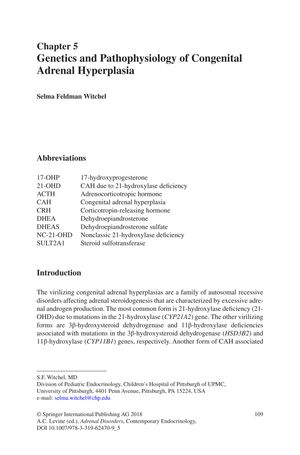TLDR The document concludes that patient outcomes for Congenital Adrenal Hyperplasia are often not ideal because of poor management and a need for better diagnosis and treatment methods.
The document from 2017 provides a comprehensive overview of Congenital Adrenal Hyperplasia (CAH), particularly the most common form, 21-hydroxylase deficiency (21-OHD). It explains that CAH is an autosomal recessive disorder with varying clinical features depending on the mutation, affecting 1:5,000 to 1:15,000 for classic forms and 1:1,000 for nonclassic CAH (NCAH). The pathophysiology involves impaired cortisol production, leading to excessive adrenal androgen production and symptoms such as ambiguous genitalia, dehydration, and hyperkalemia. The document also discusses the challenges in diagnosing NC-21-OHD due to symptom overlap with polycystic ovary syndrome (PCOS) and the complexity of the CYP21A2 gene, which has over 200 identified mutations. Treatment strategies are individualized, aiming for normal growth and symptom management, with hydrocortisone preferred for children and longer-acting glucocorticoids for adults. Prenatal dexamethasone treatment is controversial due to potential risks. The document concludes that patient outcomes are often suboptimal due to poor management, especially during the transition to adult care, and calls for improved diagnostic tools and hormone replacement regimens.
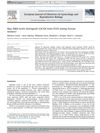 5 citations
,
April 2014 in “European Journal of Obstetrics & Gynecology and Reproductive Biology”
5 citations
,
April 2014 in “European Journal of Obstetrics & Gynecology and Reproductive Biology” AMH levels can't reliably tell the difference between LOCAH and all types of PCOS in women with excessive hair growth.
 62 citations
,
March 2011 in “European journal of endocrinology”
62 citations
,
March 2011 in “European journal of endocrinology” Some parents have a mild form of congenital adrenal hyperplasia without symptoms, and they usually don't need treatment.
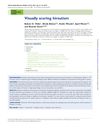 288 citations
,
June 2009 in “Human reproduction update”
288 citations
,
June 2009 in “Human reproduction update” The modified Ferriman-Gallwey method is a useful tool for diagnosing hirsutism.
 150 citations
,
November 2007 in “The Journal of Clinical Endocrinology and Metabolism”
150 citations
,
November 2007 in “The Journal of Clinical Endocrinology and Metabolism” About 2.2% of women with symptoms of high male hormones have a mild form of congenital adrenal hyperplasia, and measuring a specific hormone level can accurately diagnose it.
 6 citations
,
April 1993 in “Journal of the Royal Society of Medicine”
6 citations
,
April 1993 in “Journal of the Royal Society of Medicine” Untreated Congenital Adrenal Hyperplasia can cause severe hair loss due to high androgen levels.
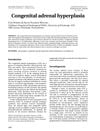 16 citations
,
September 2008 in “Dermatologic Therapy”
16 citations
,
September 2008 in “Dermatologic Therapy” CAH is a genetic disorder affecting cortisol production and causing hormonal imbalances, with treatment and diagnosis varying by form and symptoms.
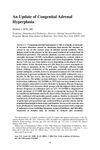 151 citations
,
December 2004 in “Annals of the New York Academy of Sciences”
151 citations
,
December 2004 in “Annals of the New York Academy of Sciences” Congenital Adrenal Hyperplasia is a genetic disorder with two forms, causing symptoms like early puberty and severe acne, but can be identified through screening and treated with glucocorticoids.
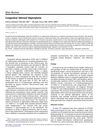 100 citations
,
May 2011 in “Journal of Pediatric and Adolescent Gynecology”
100 citations
,
May 2011 in “Journal of Pediatric and Adolescent Gynecology” The document concludes that proper diagnosis and a multidisciplinary approach are crucial for managing Congenital Adrenal Hyperplasia effectively.
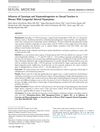 11 citations
,
August 2019 in “The Journal of Sexual Medicine”
11 citations
,
August 2019 in “The Journal of Sexual Medicine” Women with nonclassic congenital adrenal hyperplasia experience more sexual dysfunction and distress.
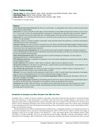
Hormones, especially testosterone and DHT, are key for penis development and function, and testosterone therapy may help with erectile dysfunction in those with low levels.
